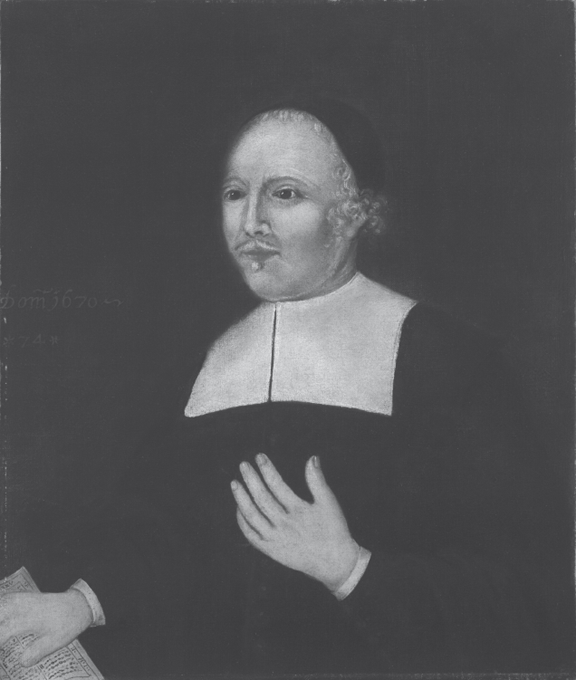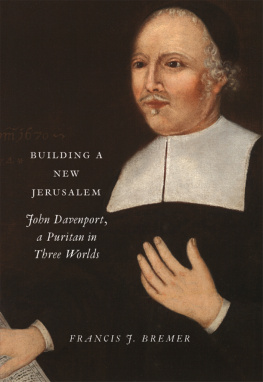B UILDING A NEW JERUSALEM

B UILDING A NEW JERUSALEM
John Davenport, a Puritan in Three Worlds
FRANCIS J. BREMER
YALE UNIVERSITY PRESS
New Haven & London
Published with assistance from the foundation established in memory of Philip Hamilton McMillan of the Class of 1894, Yale College.
Copyright 2012 by Yale University.
All rights reserved.
This book may not be reproduced, in whole or in part, including illustrations, in any form (beyond that copying permitted by Sections 107 and 108 of the U.S. Copyright Law and except by reviewers for the public press), without written permission from the publishers.
Yale University Press books may be purchased in quantity for educational, business, or promotional use. For information, please e-mail (U.K. office).
Set in Adobe Caslon Roman type by Newgen
Printed in the United States of America.
Library of Congress Cataloging-in-Publication Data
Bremer, Francis J.
Building a new Jerusalem : John Davenport, a Puritan in three worlds / Francis J. Bremer.
p. cm.
Includes bibliographical references and index.
ISBN 978-0-300-17913-2 (cloth: alk. paper)
1. Davenport, John, 15971670. 2. PuritansNew EnglandBiography. 3. PuritansConnecticutNew HavenBiography. 4. PuritansEnglandBiography. 5. PuritansNetherlandsBiography. 6. New EnglandChurch history. 7. New EnglandHistoryColonial period, ca. 16001775. 8. New Haven (Conn.)Church history. 9. New Haven (Conn.)History17th century. 10. New Haven (Conn.)Biography. I. Title.
F7.D185B74 2012
285.9092dc23
[B]
2012006783
A catalogue record for this book is available from the British Library.
This paper meets the requirements of ANSI/NISO Z39.481992 (Permanence of Paper).
10 9 8 7 6 5 4 3 2 1
: Davenport Limner, Reverend John Davenport (15971669/70), Yale University Art Gallery. Probably painted in Boston shortly before Davenports death in 1670.
publication of this book is enabled by a grant from
Jewish Federation of Greater Hartford
For Churchill, Stephen, and John Davenport, keepers of the flame
Contents
Acknowledgments
When I first began my studies of early New England, as a student of Alden T. Vaughan in the late 1960s, I was fascinated by John Davenport. My first published article was a study of the New Haven Colony and Oliver Cromwell, in which Davenport played a large role. I had hoped to write a biography of the clergyman, but publisher interest in such a project was lukewarm at best. I went on to write a number of other books on puritanism, and Davenport made a number of cameo appearances (as he often does in such works). But I never lost my interest in a book that would focus on the New Haven founder.
Following the completion of my biography John Winthrop: Americas Forgotten Founding Father (2003), I was approached by Churchill Davenport, representing many members of the Davenport family who had long hoped for a biography of their ancestor. Over the following few years, Churchill, together with his brothers John and Stephen, spearheaded a family effort that created an independent fund at Millersville University of Pennsylvania to support my research on the topic. On various occasions they helped to organize gatherings that allowed me to share my findings and test some interpretations. At no point did any of the Davenports seek to shape or influence my findings. I can assert this, because I know that in some key matters, Churchill, who has deeply immersed himself in the sources, has a different understanding of events from that which is presented in this book. Their assistance has, however, made it possible to visit more sites and to read more sources than would otherwise have been possible in the time that it has actually taken. The Davenports come first among those needing to be thanked. But as with all scholarly projects, the lists of those who have contributed to this book is so long that I fear that in listing them, some will be omitted. Nevertheless, it is important to try.
As always, John Morrill, Diarmaid MacCulloch, Tom Webster, Michael Winship, Michael McGiffert, and John Coffey have offered encouragement and have been willing to answer questions and refer me to experts in various fields. Tim Wales has been a major help in pointing me to various materials. Walt Woodward, who has done much to expand our knowledge of early New England beyond the Massachusetts story, has also provided encouragement.
Robert Davenport and Fred Hart, who have conducted their own research into the Davenport family, have been valuable contacts as I have sought to understand some of the family relationships.
In the early stages of my research Kate Harvey helped in tracking down archival sources available in England. Susan Ortmann was of great help in transcribing some of the Davenport sermon manuscripts. My understanding of the Davenports in Coventry was aided by communications with Anne Hughes, Charles Phytian-Adams, and Rob Orland. Marcus Lynch provided access to the portrait of Christopher Davenport, which was not on public display when I visited. Tom Freeman pointed me to Lady Bowess connection with Coventry and her support of evangelical clergy in the north of England.
Nicholas Tyacke, Toby Barnard, J. R. L. Highfield, Julian Reid, Robin Darwall-Smith, and Laurence Brockliss helped me with my investigations into Davenports time at Oxford and Magdalen Hall. I benefited from visiting Hilton Castle, where Davenport first preached, and I am thankful for the assistance of Pam Tate and Maurice Bates in showing me some of the area. Gill Cookson and Christine Newman helped me to understand the region both before and after my visit. Dave Bushby was of assistance in investigating the Eaton Soccon church registers for the wedding of John and Elizabeth Davenport. Andrew Fitzmaurice helped me to understand why Davenports sermon to the Virginia Company may not have been published. Joel Halcomb provided me with a copy of the Bradford manuscript that deals with the English Church in Rotterdam.
Jeremy Bangs was of great assistance during my visit to the Netherlands. He helped guide me through the Amsterdam archives and gave me the benefit of his vast knowledge of the English churches in the Netherlands in the early seventeenth century. John Cowie gave me a tour of the English Church in Amsterdam. Guus van Veldhuizen assisted me in identifying the site of the English Church in Rotterdam whose congregation was ministered to by Hugh Peter and John Davenport.
John Archer, whose work on the pattern of the New Haven town plan did much to focus my own investigations, was helpful in discussing the matter further. Jeffrey Jue and Harold Hotson were of assistance in trying to advance my investigations of Davenports links to John Dury. Jeffrey also read drafts on my work on Davenports millenarian outlook. Scott Mandelbrote was extremely helpful in my assessment of the importance of the Jerusalem temple in the thought of the period, and particularly for Davenport. Diarmaid MacCulloch pointed out the importance of such models in the Spanish colonies in the New World. Anton Klas facilitated my obtaining a copy of the Templo print used as an illustration.
A number of people assisted me in trying to understand Davenports medical condition. These included Andrew Wear, Kevin Siena, Robert Charles Anderson, and Norman Gevitz.
Winfried Herget pointed me to unpublished notes of some Davenport sermons. In exploring the accuracy of the Morgan thesis, I benefited greatly from the willingness of the following to read my drafts and offer their comments, negative as well as positive: Michael McGiffert, E. Brooks Holifield, Michael Ditmore, Michael Winship, Joel Halcomb, Hunter Powell, Jeff Cooper, Crawford Gribben, Mark Peterson, and Tom Webster.
Next page










